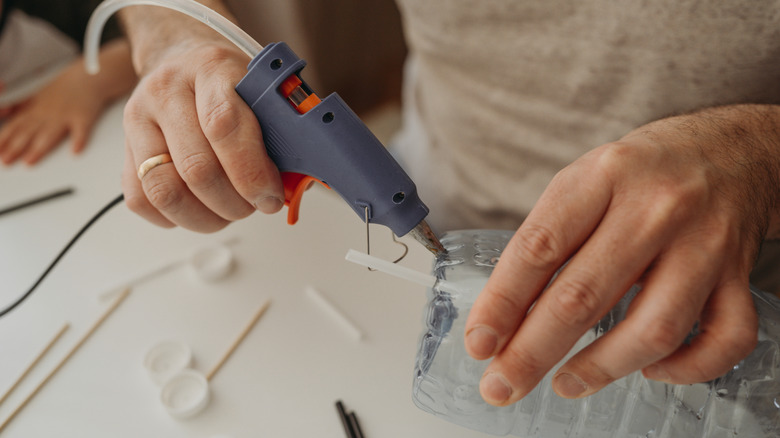The Secret To A Better Hot Glue Gun Experience Is Sitting In Your Medicine Cabinet
There is nothing quite as important to a DIYer as a hot glue gun, but there is also nothing quite as frustrating as the mess that comes with using one. You are out there just wanting to finish a project, but then strings of glue seem to follow your every move while dried clumps build up on the nozzle. Before you know it, your once-neat project looks like a disaster that needs cleaning.
But don't fret! You probably already own the secret to a smoother and better hot glue gun experience. Applying a small bit of petroleum jelly or Vaseline — the medicine cabinet staple also used to prevent frozen locks – to the tip of your glue gun creates a protective barrier that keeps glue from sticking to the nozzle. Yes, not only can you use Vaseline to bring scuffed up wooden cabinets back to life, but it also reduces those annoying glue strings and prevents clumps from building up. The result is a cleaner tool and a more polished project. It's a straightforward hack that can make a big difference in your crafting routine.
Before you do this trick, make sure that your glue gun is completely cool and unplugged. Then, grab a cotton swab or a small clean cloth and dip it into a bit of petroleum jelly. Gently coat the metal tip of the glue gun with a thin layer of the petroleum jelly or just enough to cover the surface. Be careful not to use too much since you don't want it dripping or getting inside the glue gun. Plug in your glue gun and let it heat up once done with the process!
How to safely use petroleum jelly for a cleaner glue gun experience
This hack works because petroleum jelly is a lubricant, so it naturally repels sticky substances like glue. The thin layer of petroleum jelly creates a non-stick barrier that prevents glue from adhering to the nozzle. Keeping the nozzle slick also minimizes the mess and makes it easier to control where the glue goes. Any dried glue on the nozzle can be wiped away effortlessly with a cloth.
There are a few things to keep in mind to make this hack safe. First, do not overdo the petroleum jelly so as to prevent it from dripping into the glue gun or its plastic parts. This might lead to clogs or your tool overheating, which can then pose a clear potential fire hazard. One more thing to consider is the type of glue sticks you're using. Some specialty adhesives, like high-heat or industrial-strength formulas, might not work as well since they are more durable than regular ones.
Lastly, always do a small test before using this trick on delicate materials. Petroleum jelly generally shouldn't transfer onto your project, but it's better to be safe, especially when working with heat and adhesives. Certain textiles or porous surfaces may react differently, after all, so checking first can help prevent any issues. Keeping these in mind can help you make the most of this hack while ensuring you have a glue gun that is clean and ready for projects.
